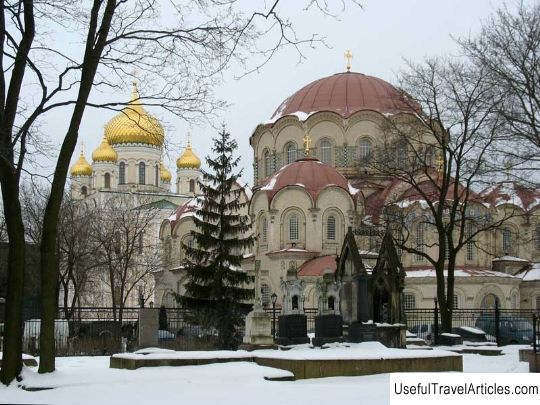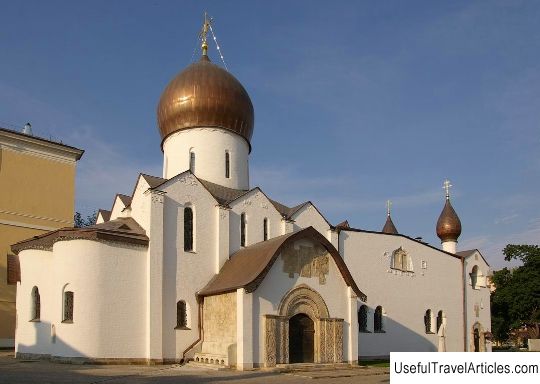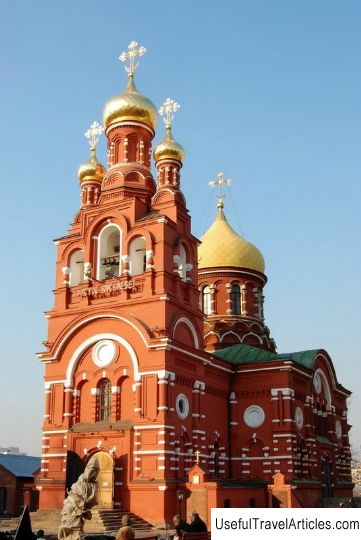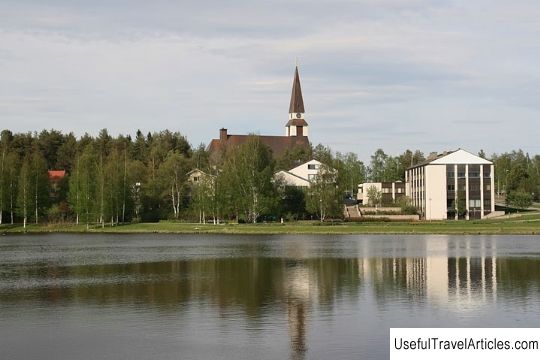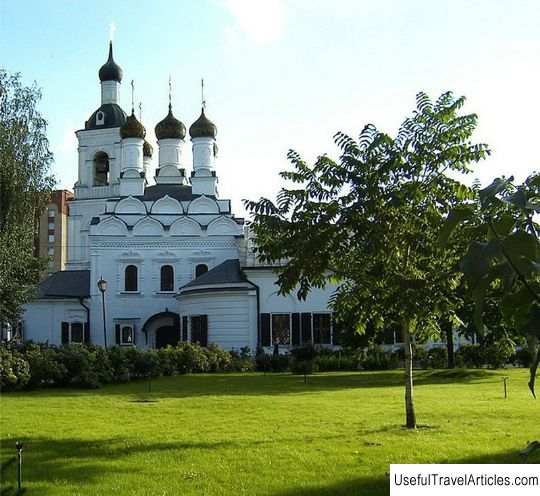Novodevichy Convent description and photos - Russia - Moscow: Moscow
Rating: 8,1/10 (745 votes) 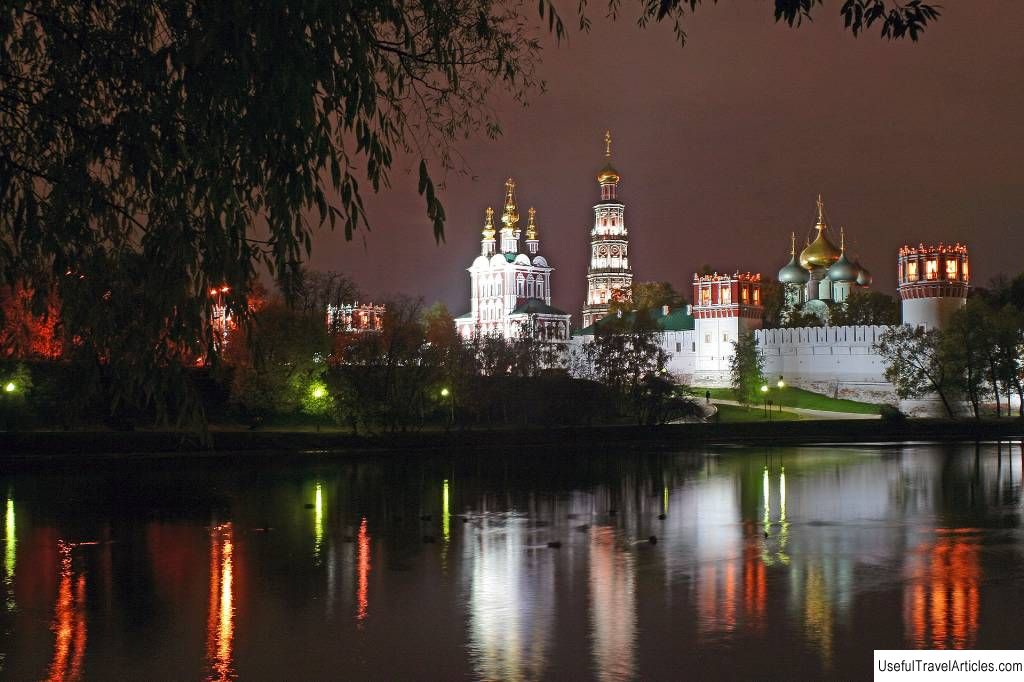
Novodevichy Convent description and photos - Russia - Moscow: Moscow. Detailed information about the attraction. Description, photos and a map showing the nearest significant objects. Photo and descriptionThe Orthodox Women's Novodevichy Convent is one of the most important architectural, historical and cultural attractions of the capital of the Russian Federation. According to the Patriarchal charter of 1598, its full name sounds like The Most Holy Great Monastery of the Most Pure Theotokos “Hodegetria” New Maiden Monastery . The complex of buildings of the monastery is located on Bolshaya Pirogovskaya street in the historical area of Moscow, called the Devichye Pole. History of the foundation of the monasteryThe monastery was founded by decree of Grand Duke Vasily III in 1524. Ten years earlier, during the Russian-Lithuanian war, Russian troops from the front line of the army undertook a siege of Smolensk. The military campaign lasted just over two months, and, as a result of a powerful onslaught, the Lithuanian garrison laid down its arms. Residents of the city came out to greet the liberators, carrying in their arms the miraculous image of the Smolensk Icon of the Mother of God "Hodegetria" . The victory was the largest military success of the Grand Duke Vasily III. In gratitude to "Hodegetria" the prince ordered to found a monastery. The image of the Smolensk Icon of the Mother of God "Hodegetria" was painted, according to legend, by the Evangelist Luke. The icon was kept in the Church of Constantinople, and ended up in Russia in 1046 together with Princess Anna, who was issued by Emperor Constantine IX Monomakh for Prince Vsevolod Yaroslavich. Then Vladimir Monomakh transferred the icon to Smolensk in the newly formed temple of the Assumption of the Mother of God, and the icon received a new name - Smolensk. In the 15th century, "Odigitria" ended up in Moscow, where an exact list or copy was removed from it, and the image returned to Smolensk at the request of the local bishop. The site for the construction of the monastery was not chosen by chance. It was in the bend of the Moskva River on Devichye Pole that Muscovites bid farewell to the image of Our Lady of Smolensk in 1456 . Prince Vasily III granted three thousand silver rubles for the construction of the monastery, the monastery was exempted from paying any taxes and taxes to the treasury. In early August 1525, a procession of the cross was made from the Kremlin to the Maiden Field, led by the Grand Duke. The list from the "Hodegetria" was solemnly transferred to the monastery, and an annual patronal feast was established in memory of this event. Some historians believe that the foundation of the monastery did not coincide in time with the divorce of Basil III, who was in a hurry to get rid of his childless wife. In a long marriage, he had no heirs. The Grand Duchess Solomonia Saburova could not give birth and, fearing that the sons of his brothers would enter the throne, Vasily III obtained permission for divorce and remarriage. The Grand Duchess was exiled to the Moscow Theotokos-Rozhdestvensky Monastery, where she was tonsured under the name Sophia. It is believed that the Novodevichy monastery was built precisely in order to then receive the Grand Duchess, but the newly-appeared Sophia died in the Intercession Monastery of Suzdal, where she found herself after taking monasticism. Court monastery The status of a court monastery for Novodevichy was fixed under Ivan the Terrible. During his reign, the closest relatives of the Russian tsar settled in the monastery - the widow of his younger brother Princess Paletskaya and the widow of the son of Tsarevich Ivan Ivanovich Princess Elena Sheremeteva. Tsarina Irina Fedorovna Godunova moved to the Novodevichy Convent on the ninth day after the death of her husband Fyodor I Ioannovich. By status, she was the only heir to the Russian throne and continued to conduct business within the walls of the monastery. Her brother Boris Godunov, who took refuge with her in a monastery, received a petition for the kingdom from the boyars there. Having received the blessing of Irina Fyodorovna, Boris Godunov was elected to the kingdom, and under him the monastery received a special royal favor. Smolensk Cathedral was renewed and repaired, a new iconostasis was added, built the Irininsky chambers and the house church of John the Baptist. At the end of the 16th century, old women lived in the monastery, among whom there were many owners of noble princely families - Rostov and Sheremetevs, Beklemishevs and Pleshcheevs, Meshchersky and Pronsky. In the Time of Troubles, the monastery hid royal persons - the daughters of Tsar Boris Godunov and his cousin Vladimir Staritsky. Then the monastery was seized by traitors to the boyars, and in the period from 1610 to 1612 it changed hands more than once. With the coming to power of the Romanovs, the monastery began to be actively restored, and by 1650 it was cleaned and repaired. Thirty years later, an iconostasis appeared in the main cathedral, on the creation of which the famous Russian masters of the Armory worked. Supervised the work Klim Mikhailov and Semyon Ushakov . The further fate of the monastery was not easy either. The retreating Napoleonic troops tried to blow up the monastery, and the Bolsheviks practically abolished it, opening the Museum of Women's Emancipation within the walls of the monastery. Later, the Novodevichy Convent was included in the list of branches of the State Historical Museum. The monastic community was renewed in 1994 , in 2009 the oldest copy of the Iberian Icon of the Mother of God returned to the monastery. A year later, the monastery was transferred to the Moscow diocese. Architectural ensemble During the reign of Ivan the Terrible, the territory of the Novodevichy Convent was surrounded by fortress walls, almost completely rebuilt a century later. The center of the architectural complex is the Cathedral Church of the Smolensk Icon of the Mother of God , erected in the first third of the 16th century. The monastery's oldest cathedral is similar to the Assumption in the Kremlin. The church has preserved wall paintings from the beginning of the 16th century and an iconostasis made in the second half of the 17th century. Several other monuments of Russian stone architecture are worthy of attention on the territory of the monastery: - In the 80s In the years of the 17th century the Church of the Assumption of the Blessed Virgin Mary was built. Its chapels are dedicated to John the Theologian, Prince Vladimir and the Descent of the Holy Spirit. At the same time, a refectory appeared at the Assumption Church. - Belfry of the Novodevichy Convent is a striking example of the architectural style called Naryshkin Baroque. The five-story tower rises 72 meters. It is made up of octahedral tiers tapering upward, called eights and decorated with trims, columns, white-stone lace patterns. A drum with a gilded dome is installed at the top of the bell tower. - Above the northern gates of the monastery, in the same period as the bell tower, the Transfiguration Gate Church was built. Today, the temple is a home for Metropolitan Krutitsky and Kolomenskoye and you can only look at it from the outside. - The Lopukhinsky Chambers , built at the end of the 17th century for the daughter of Tsar Alexei Mikhailovich, have become a continuation of the Transfiguration Church. Half a century later, Evdokia Lopukhina settled in the wards, and the building got its name in honor of the first wife of Tsar Peter I. The facade of the Lopukhinsky Chambers is remarkable, on which you can see the oldest sundial in the capital. - Above the southern entrance to the monastery rises Pokrovskaya gateway church . The Church of the Intercession of the Most Holy Theotokos was built in the 80s of the 17th century. - The Church of the Intercession is adjoined by chambers named after the daughter of Tsar Alexei Mikhailovich Mariinsky . Maria Alekseevna lived in the monastery in the 90s of the 17th century. - The small Church of Ambrose of Mediolansky was previously consecrated in honor of John the Baptist. Its construction dates back to the end of the 16th century. - Next to the Amvrosievskaya Church you can see the chambers of Tsarina Irina Godunova the end of the 16th century and a two-story building of the former refectory. - In the chambers of Princess Sophia in the streltsy guardhouse at the Naprudnaya Tower, a museum exposition is arranged. The interior is decorated with tiled stoves built in the 17th century. - The magnificent mosaics covering the walls of the chapel-burial vault of the Prokhorovs have been perfectly preserved to this day. The building is considered an example of the neo-Russian style popular at the turn of the 19th and 20th centuries. The chapel was built in 1911. On the territory of the Novodevichy Convent, towers of the fortress walls, completely rebuilt at the end of the 17th century, are worthy of special attention. The openwork tops of the towers are made of bricks and decorated with arched openings, loopholes, columns, weights and icon cases. The Nikolskaya, Naprudnaya and Chebotarnaya towers and the majestic square Tsaritsynskaya look especially picturesque. The necropolis of the Novodevichy Convent Initially, the nuns of the monastery and the city nobility were buried in the Smolensk Cathedral. In 1898, the Novodevichye Cemetery appeared behind the southern wall of the monastery, which by the middle of the twentieth century had become one of the most prestigious burial places in the capital. In the Smolensk Cathedral, around it and in the Assumption Church the monastery rests Tsarina Evdokia Lopukhina, the former first wife of Peter I, Princess Sophia Alekseevna, Anna Ioannovna, Princess Elena Sheremeteva, heroes of the war of 1812 Denis Davydov and Dmitry Volkonsky, participants in the Decembrist uprising on Senate Square S. Trubetskoy and A. Muravyov, writer A. Pisemsky and poet A. Pleshcheev, famous philosophers, lawyers, professors and generals. In the new cemetery of the Novodevichy Convent, famous figures of art, literature and important political figures of the 20th century are buried . Here are the graves of Anton Chekhov, Isaac Levitan, Nikita Khrushchev, Boris Yeltsin, Lyubov Orlova. Special attention should be paid to memorial steles and tombstones, the authors of which are the most famous Russian and Soviet artists and sculptors. In 2004, the architectural ensemble of the monastery was included by UNESCO in the list of World Heritage of Humanity. Today the Novodevichy Convent is part of the State Historical Museum.          We also recommend reading Winter theater description and photos - Russia - South: Sochi Topic: Novodevichy Convent description and photos - Russia - Moscow: Moscow. |
